Abstract
Thoracoabdominal motion and intrathoracic (oesophageal), intra-abdominal (gastric), and transdiaphragmatic pressures were measured during tidal breathing in 20 erect subjects--six normal, seven, with emphysema, and seven with fibrosing alveolitis. In normal subjects all diameters increased synchronously during inspiration and were accompanied by rises in abdominal and transdiaphragmatic pressures. Five patients with fibrosing alveolitis showed a reduction in upper ribcage motion, but normal lower ribcage and abdominal motion; stiff fibrotic lungs may sometimes impair the ability of the diaphragm to expand the upper ribcage and result in proportionally more expansion of the bases. Four emphysematous patients showed increased anteroposterior motion of the ribcage and four showed paradoxical inward motion of the lower ribcage during inspiration. These changes apparently result from increased activity of intercostal and accessory muscles and altered configuration of the diaphragm. The muscles of patients with large, overinflated lungs are at a greater disadvantage than those with small fibrosed lungs.
Full text
PDF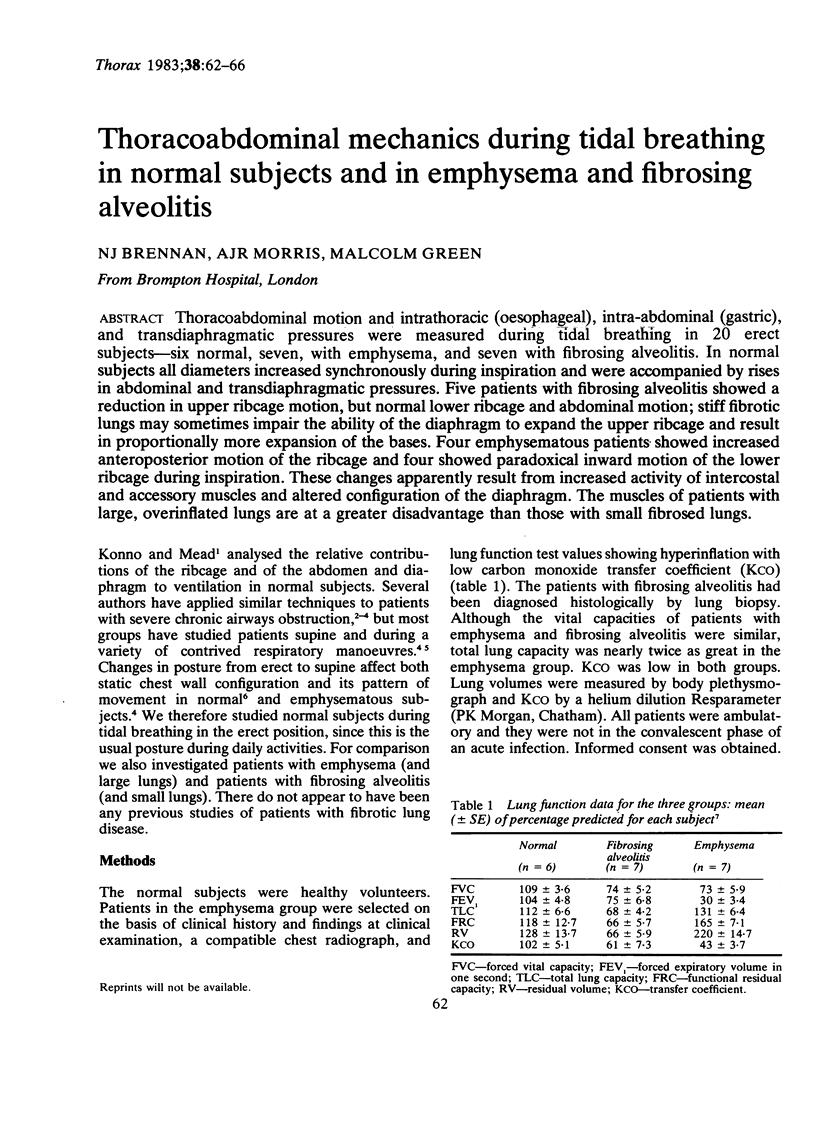
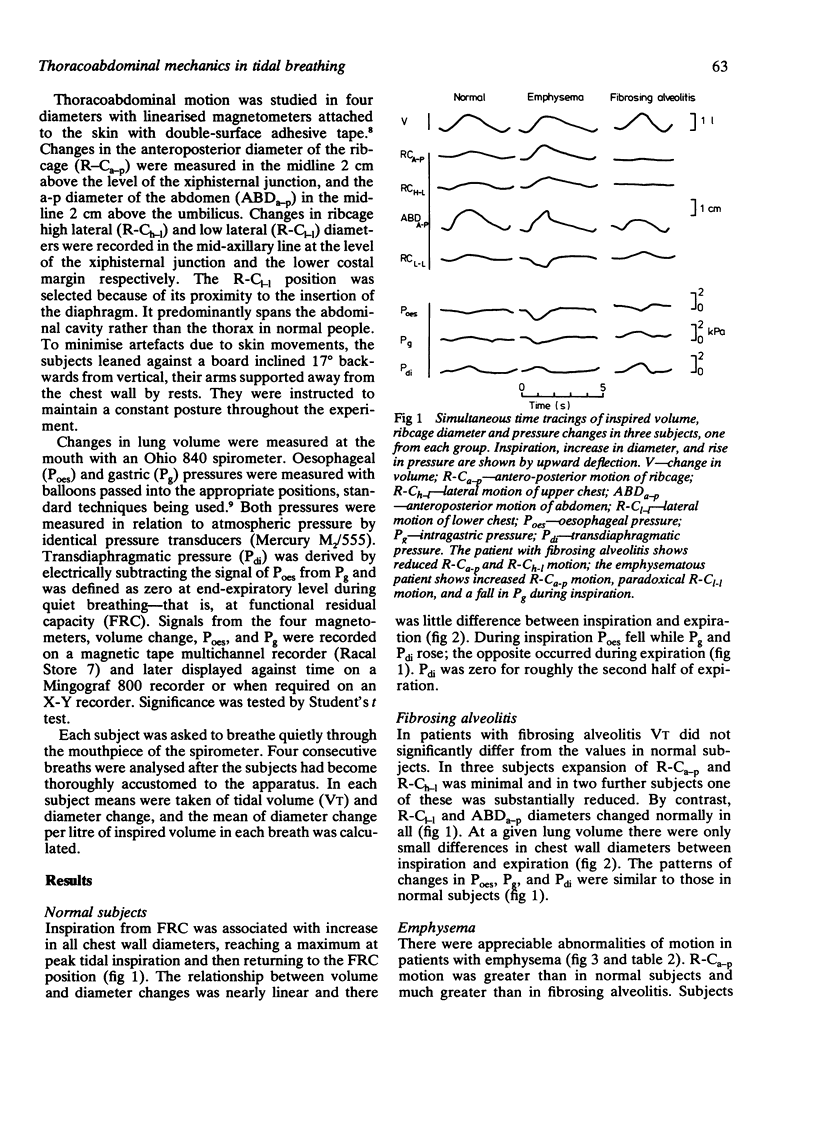
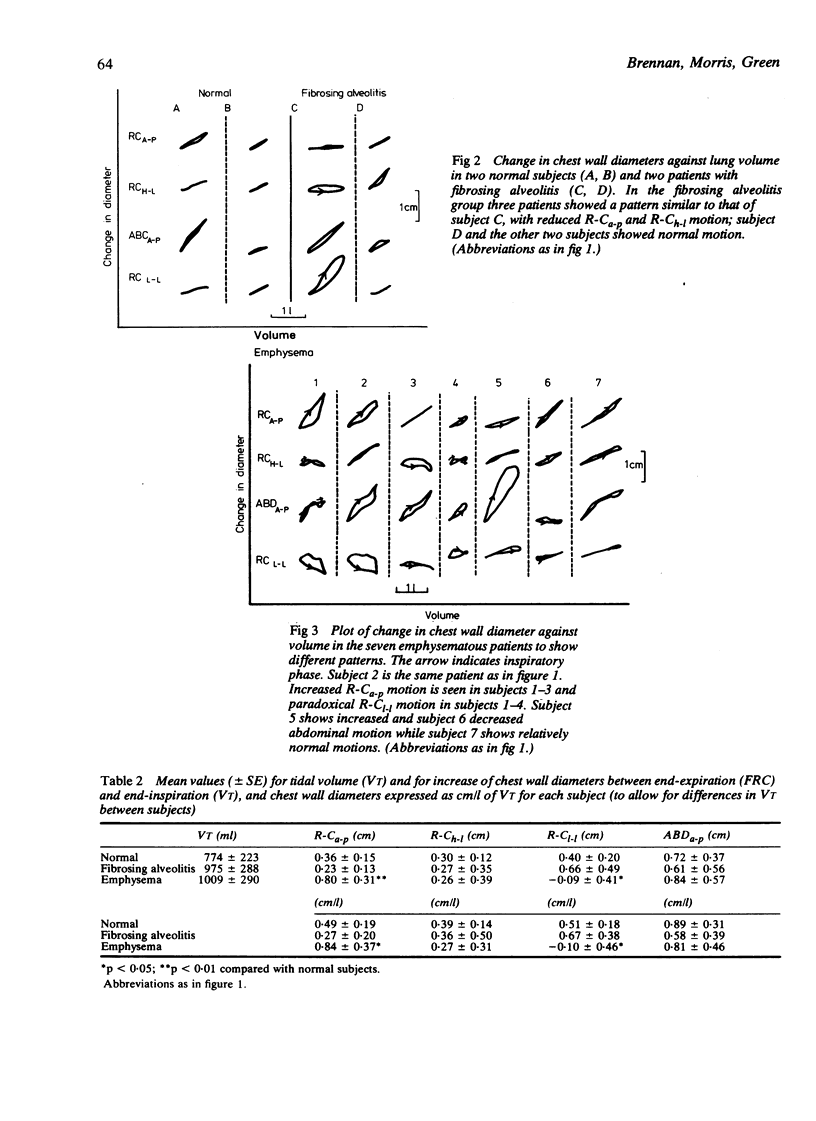
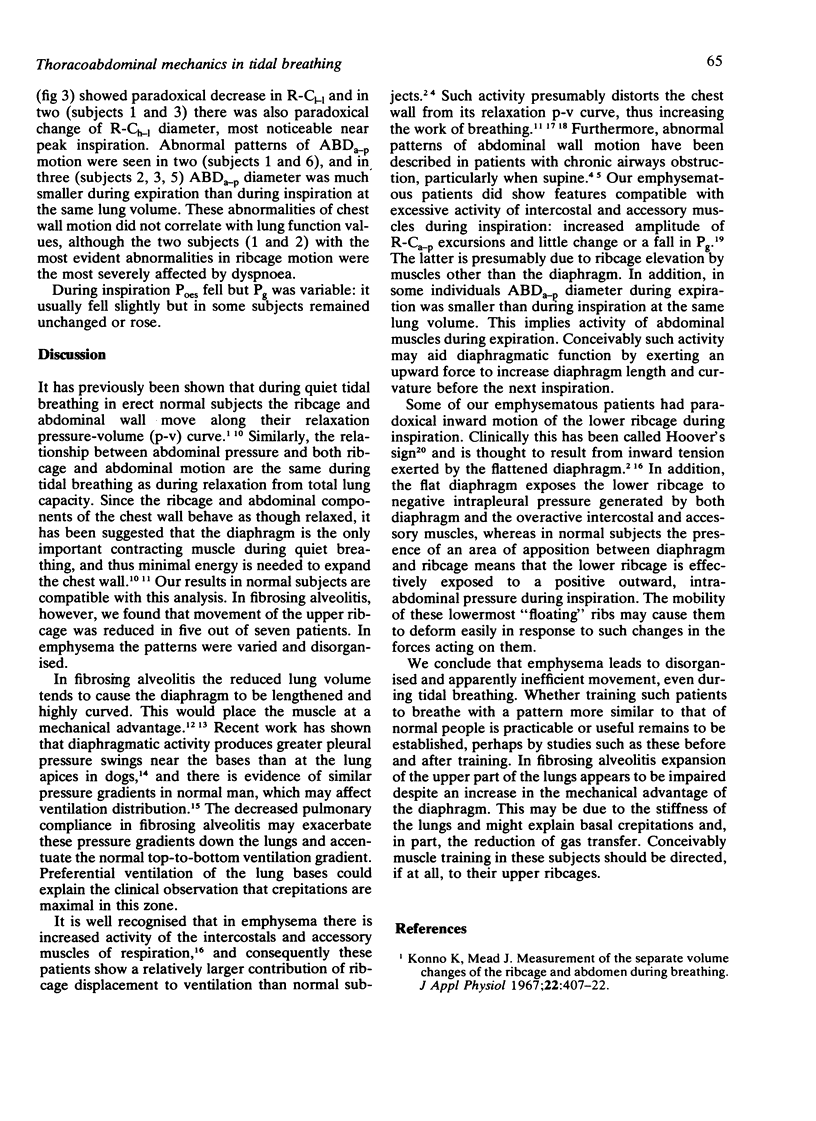
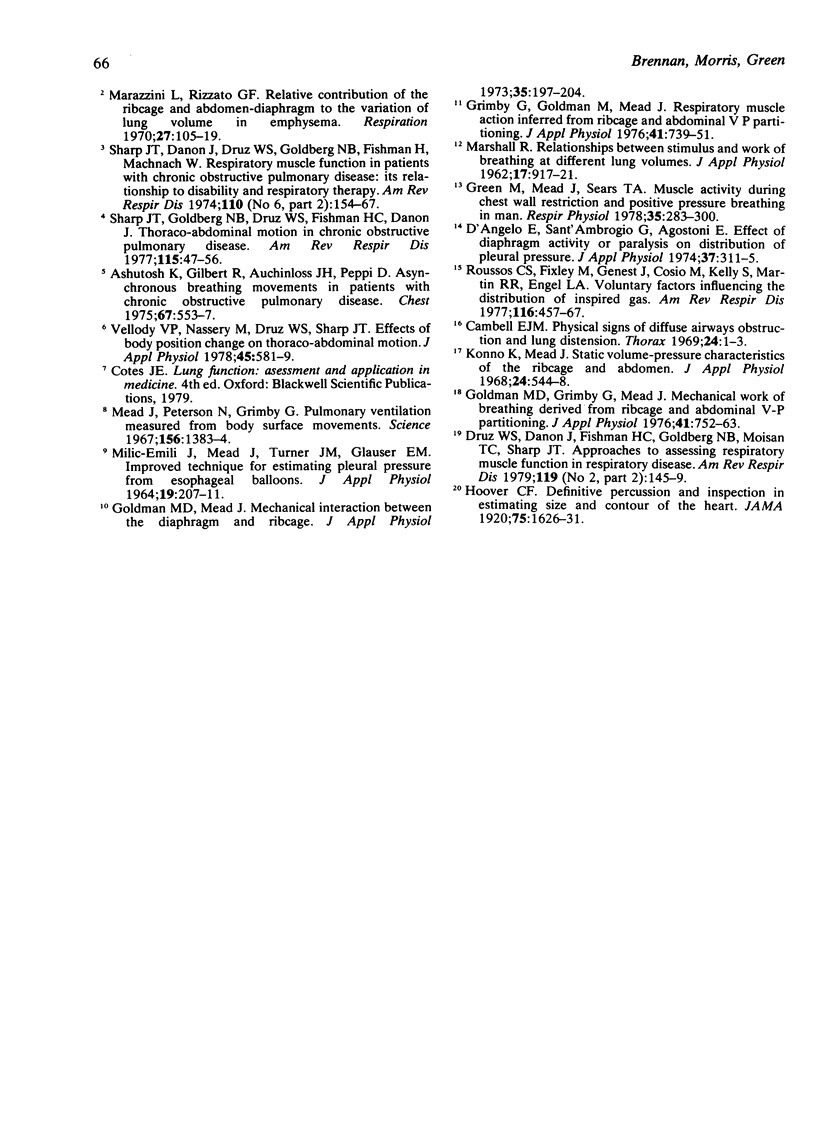
Selected References
These references are in PubMed. This may not be the complete list of references from this article.
- Ashutosh K., Gilbert R., Auchincloss J. H., Jr, Peppi D. Asynchronous breathing movements in patients with chronic obstructive pulmonary disease. Chest. 1975 May;67(5):553–557. doi: 10.1378/chest.67.5.553. [DOI] [PubMed] [Google Scholar]
- Campbell E. J. Physical signs of diffuse airways obstruction and lung distension. Thorax. 1969 Jan;24(1):1–3. doi: 10.1136/thx.24.1.1. [DOI] [PMC free article] [PubMed] [Google Scholar]
- D'Angelo E., Sant'Ambrogio G., Agostoni E. Effect of diaphragm activity or paralysis on distribution of pleural pressure. J Appl Physiol. 1974 Sep;37(3):311–315. doi: 10.1152/jappl.1974.37.3.311. [DOI] [PubMed] [Google Scholar]
- Druz W. S., Danon J., Fishman H. C., Goldberg N. B., Moisan T. C., Sharp J. T. Approaches to assessing respiratory muscle function in respiratory disease. Am Rev Respir Dis. 1979 Feb;119(2 Pt 2):145–149. doi: 10.1164/arrd.1979.119.2P2.145. [DOI] [PubMed] [Google Scholar]
- Goldman M. D., Grimby G., Mead J. Mechanical work of breathing derived from rib cage and abdominal V-P partitioning. J Appl Physiol. 1976 Nov;41(5 Pt 1):752–763. doi: 10.1152/jappl.1976.41.5.752. [DOI] [PubMed] [Google Scholar]
- Goldman M. D., Mead J. Mechanical interaction between the diaphragm and rib cage. J Appl Physiol. 1973 Aug;35(2):197–204. doi: 10.1152/jappl.1973.35.2.197. [DOI] [PubMed] [Google Scholar]
- Green M., Mead J., Sears T. A. Muscle activity during chest wall restriction and positive pressure breathing in man. Respir Physiol. 1978 Dec;35(3):283–300. doi: 10.1016/0034-5687(78)90004-x. [DOI] [PubMed] [Google Scholar]
- Grimby G., Goldman M., Mead J. Respiratory muscle action inferred from rib cage and abdominal V-P partitioning. J Appl Physiol. 1976 Nov;41(5 Pt 1):739–751. doi: 10.1152/jappl.1976.41.5.739. [DOI] [PubMed] [Google Scholar]
- Konno K., Mead J. Measurement of the separate volume changes of rib cage and abdomen during breathing. J Appl Physiol. 1967 Mar;22(3):407–422. doi: 10.1152/jappl.1967.22.3.407. [DOI] [PubMed] [Google Scholar]
- Konno K., Mead J. Static volume-pressure characteristics of the rib cage and abdomen. J Appl Physiol. 1968 Apr;24(4):544–548. doi: 10.1152/jappl.1968.24.4.544. [DOI] [PubMed] [Google Scholar]
- MILIC-EMILI J., MEAD J., TURNER J. M., GLAUSER E. M. IMPROVED TECHNIQUE FOR ESTIMATING PLEURAL PRESSURE FROM ESOPHAGEAL BALLOONS. J Appl Physiol. 1964 Mar;19:207–211. doi: 10.1152/jappl.1964.19.2.207. [DOI] [PubMed] [Google Scholar]
- Marazzini L., Rizzato G. F. Relative contribution of rib cage and abdomen-diaphragm to the variation of lung volume in emphysema. Respiration. 1970;27(2):105–119. doi: 10.1159/000192676. [DOI] [PubMed] [Google Scholar]
- Mead J., Peterson N., Grimby G., Mead J. Pulmonary ventilation measured from body surface movements. Science. 1967 Jun 9;156(3780):1383–1384. doi: 10.1126/science.156.3780.1383. [DOI] [PubMed] [Google Scholar]
- Roussos C. S., Fixley M., Genest J., Cosio M., Kelly S., Martin R. R., Engel L. A. Voluntary factors influencing the distribution of inspired gas. Am Rev Respir Dis. 1977 Sep;116(3):457–467. doi: 10.1164/arrd.1977.116.3.457. [DOI] [PubMed] [Google Scholar]
- Sharp J. T., Danon J., Druz W. S., Goldberg N. B., Fishman H., Machnach W. Respiratory muscle function in patients with chronic obstructive pulmonary disease: its relationship to disability and to respiratory therapy. Am Rev Respir Dis. 1974 Dec;110(6 Pt 2):154–168. doi: 10.1164/arrd.1974.110.6P2.154. [DOI] [PubMed] [Google Scholar]
- Sharp J. T., Goldberg N. B., Druz W. S., Fishman H. C., Danon J. Thoracoabdominal motion in chronic obstructive pulmonary disease. Am Rev Respir Dis. 1977 Jan;115(1):47–56. doi: 10.1164/arrd.1977.115.1.47. [DOI] [PubMed] [Google Scholar]
- Vellody V. P., Nassery M., Druz W. S., Sharp J. T. Effects of body position change on thoracoabdominal motion. J Appl Physiol Respir Environ Exerc Physiol. 1978 Oct;45(4):581–589. doi: 10.1152/jappl.1978.45.4.581. [DOI] [PubMed] [Google Scholar]


